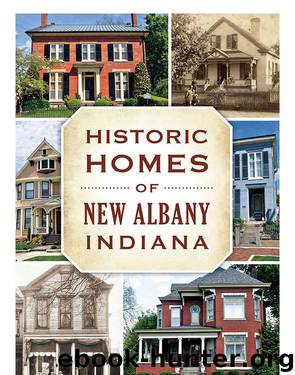Historic Homes of New Albany, Indiana (Landmarks) by Barksdale David C. & Sekula Gregory A

Author:Barksdale, David C. & Sekula, Gregory A. [Barksdale, David C.]
Language: eng
Format: epub
Publisher: Arcadia Publishing Inc.
Published: 2015-11-02T05:00:00+00:00
CRAWFORD -MOOSMILLER HOUSE
820 East Market Street
Now the home of the nonprofit Arts Council of Southern Indiana, this two-story brick town house was constructed sometime after 1852 by John B. Crawford. He, in turn, sold the house to Adam Knapp in December 1855. Knapp was a partner in the business concern of Knapp and Gohmann, dealers in wholesale groceries, liquors and tobacco. The business was located on Pearl Street.
By March 1863, Merchants National Bank president Jacob Hangary owned the property. Upon his death in January 1880, his daughter and son-in-law, Mary A. and Colonel John S. Day, purchased the home. Colonel Day was involved in New Albany railroads at an early age, having worked his way from the freight office to superintendent of the Louisville, New Albany & Chicago Railroad, later known as the Monon. After retirement, he managed extensive lumber interests and was an original investor in the New Albany Steam Forge Company. Day was also active in local and state politics, serving twice on the New Albany City Council and two terms in the Indiana Senate. He died in July 1893.
Following the death of Colonel Day, his widow remained in the home and was joined by her daughter and son-in-law, Mary and Paul E. Moosmiller. Paul E. Moosmiller was an architect. Around 1901, he designed a separation of the house into two individual residences, with the former rear wing becoming 221 East Ninth Street. At the same time, Moosmiller designed a new west wing for this home, along with a room extension on the east containing a new staircase to the second floor. A Classical Revival–style front porch was also added to the house but was subsequently removed in a 1970s renovation by then owners Sam and Paula Robinson. The couple saved the house from certain destruction after years of vacancy and vandalism. In 2005, the Arts Council of Southern Indiana was able to obtain the house as its headquarters through a successful capital campaign, including gifts from several major donors.
Download
This site does not store any files on its server. We only index and link to content provided by other sites. Please contact the content providers to delete copyright contents if any and email us, we'll remove relevant links or contents immediately.
| Africa | Americas |
| Arctic & Antarctica | Asia |
| Australia & Oceania | Europe |
| Middle East | Russia |
| United States | World |
| Ancient Civilizations | Military |
| Historical Study & Educational Resources |
Cat's cradle by Kurt Vonnegut(14785)
Pimp by Iceberg Slim(13809)
Underground: A Human History of the Worlds Beneath Our Feet by Will Hunt(11850)
4 3 2 1: A Novel by Paul Auster(11823)
The Radium Girls by Kate Moore(11642)
Wiseguy by Nicholas Pileggi(5336)
American History Stories, Volume III (Yesterday's Classics) by Pratt Mara L(5141)
Perfect Rhythm by Jae(5084)
The Fire Next Time by James Baldwin(5034)
Paper Towns by Green John(4815)
Pale Blue Dot by Carl Sagan(4633)
A Higher Loyalty: Truth, Lies, and Leadership by James Comey(4568)
The Mayflower and the Pilgrims' New World by Nathaniel Philbrick(4288)
The Doomsday Machine by Daniel Ellsberg(4254)
Killers of the Flower Moon: The Osage Murders and the Birth of the FBI by David Grann(4199)
Too Much and Not the Mood by Durga Chew-Bose(4105)
The Sympathizer by Viet Thanh Nguyen(4100)
The Borden Murders by Sarah Miller(4033)
Sticky Fingers by Joe Hagan(3918)
